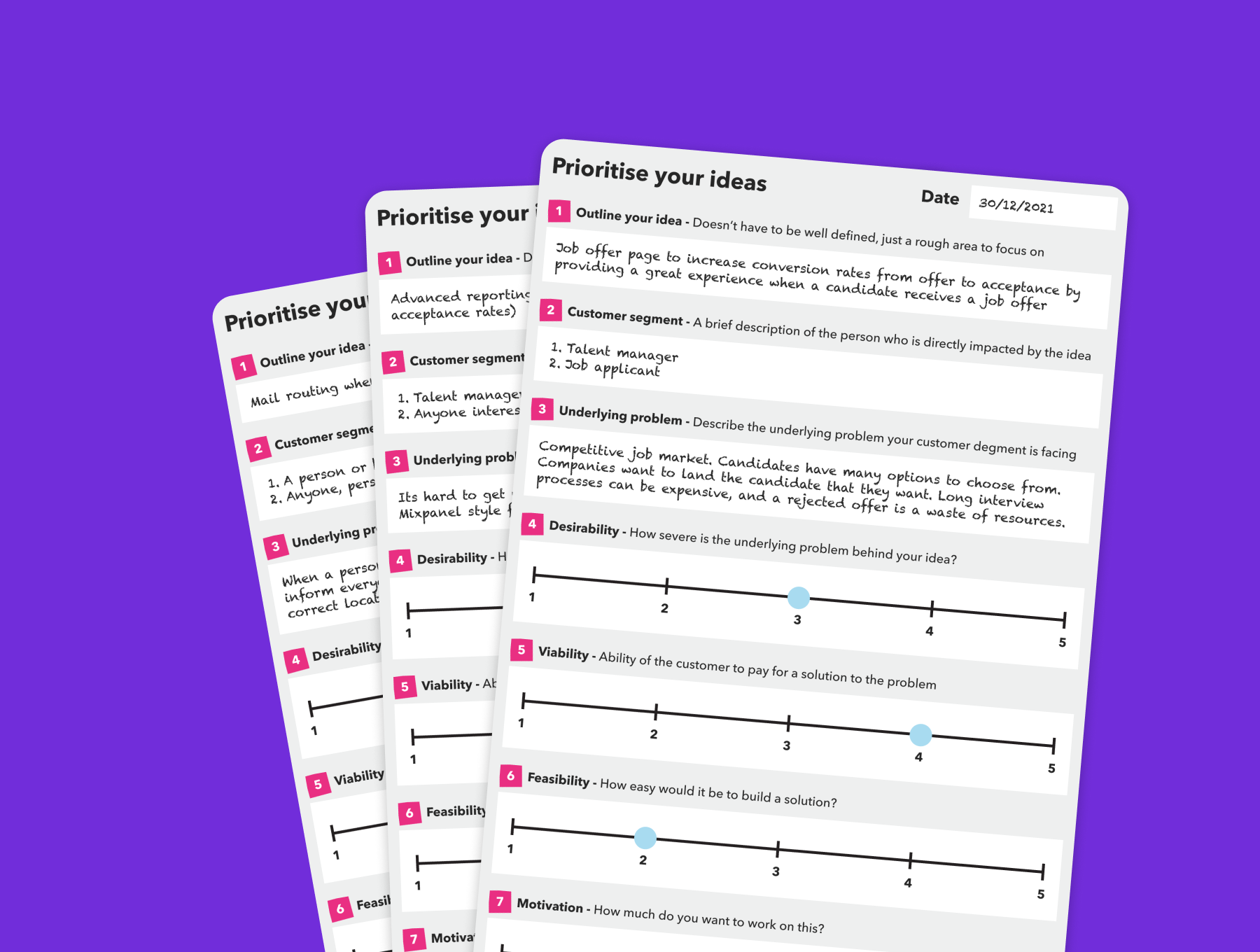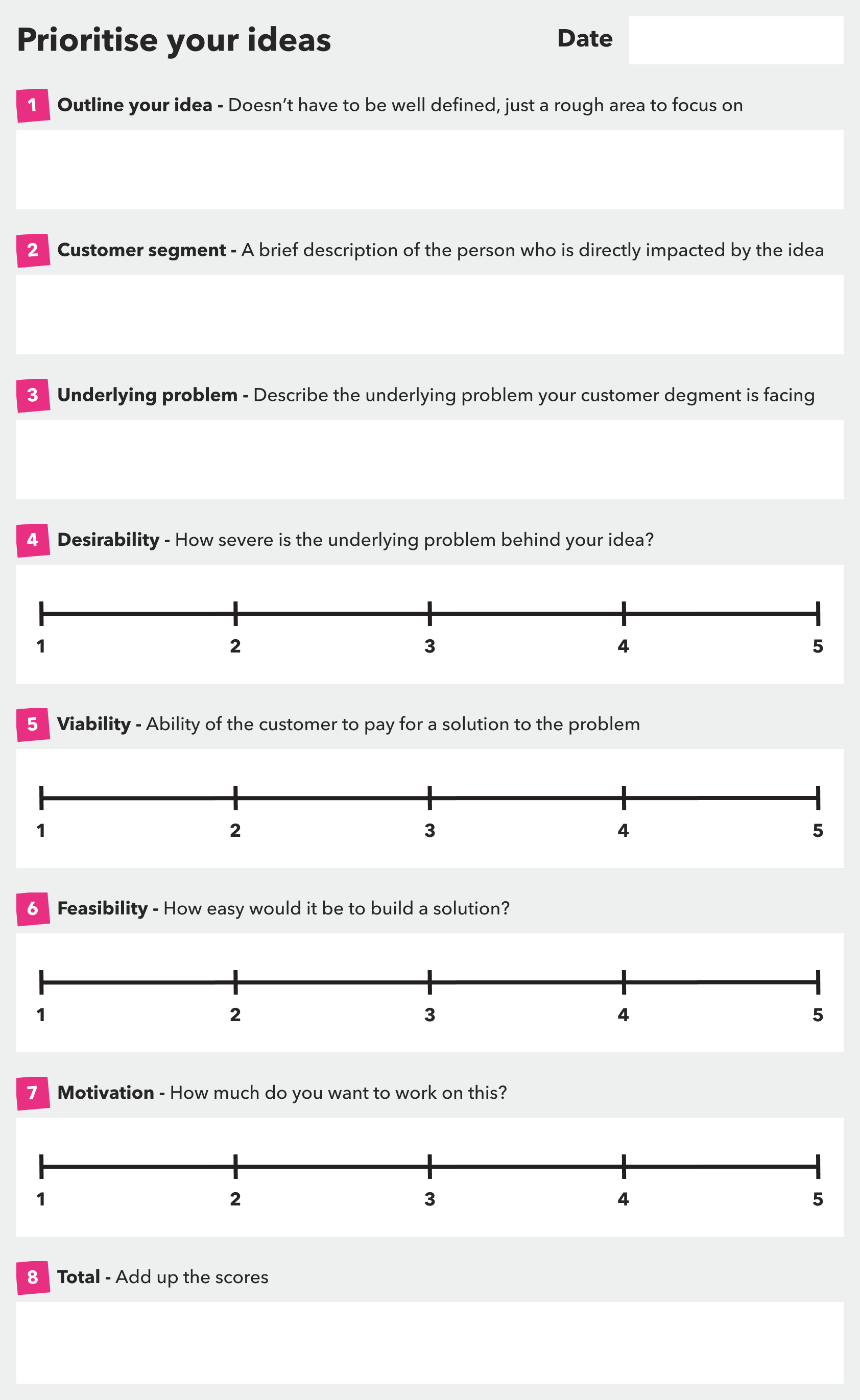How I selected a project to build for #BuildSell30
5 min read

It’s 2nd January 2022 and the inevitable New Years Day hangover has subsided, which means it’s time to kick off my #BuildSell30 project.
First things first; I need to select a project to work on.
The criteria
Here is the primary criteria for my idea selection:
Solve a real problem
The user should ideally have the ability to pay for a solution
Achievable to build in a short period of time
Something I want to work on
This is loosely based on Desirability, Viability, and Feasibility risk as outlined by Strategyzer. You can read more about this in this blog post by Strategyzer.
Desirable: Solve a real problem
I’ve read enough YC and Paul Graham to know that when it comes to building a digital business there’s one thing that matters more than anything else; make something people want.
That means we need start by ensuring we are solving a real problem that people have. I have products ideas all of the time and try to write them down when I think of them. But I am aware that I can fall into the trap of wanting to build something because I think it would be cool, rather than focussing on solving a problem.
As a preference, I want the project to be based on solving a problem that I have I have noticed or heard people mention in a professional setting.
Viable: A user with the ability to pay for a solution
If we are to build a business around our product, we need to ensure that the person who has the problem is able to pay for a solution.
Having studied and worked as a Product Designer, when I began working with startups it was unnatural to me to think about his side of things. But the truth is; if no one will pay for or fund it, then there will be no solution and the problem will not be solved.
I think it is easy for new builders to fear a B2B model and dismiss doing so because they are intimidated by and don’t think they currently understand the intricacies of businesses they want to serve. I would certainly put myself in this category up until this point.
Typically, however, B2B represents fertile ground solve a problem for someone with a budget to spend. B2B products often fall short of usability and experience standards that we have come to expect in consumer products. While this has shifted over the last 10 years, there is still plenty of room for improvement.
Enjoying this post?
Check out the video version
Feasible: Achievable to build in a short period of time
A challenge of this type inherently brings its own constraints, most obviously the time limit of building and selling the project in 30 days.
I have spent the last few years dabbling with code in my spare time and I am now proficient enough to build a web app using React as my framework, so this should come in handy.
Because of this exceptionally short time frame, I need to promote and even maybe even sell the product before we have even finished building a working version.
I plan on building an MVP in the form of a landing page describing the proposition, writing about the product, and gaining as much exposure to out target market as possible.
It’s important that we try to talk to interact with potential customers. Once a customer signs up, I will tell them that the product is not ready yet but ask them a few questions around why they wanted to sign up, why were they looking now, and what other solutions have they tried.
You could even provide a fake “check out” to simulate payment intent, or even generate your first revenue before writing a line of code by asking users to pre-order the product.
Motivation: Something I want to work on
Lastly, I need to ensure I’m working on something which I am motivated enough to want to get up (or stay up) and work on.
I will not pretend that the other criteria will not influence this metric, as a customer with a big budget and a strong problem would certainly make me more motivated to work on a solution.
This is here as a bit of a sense check to see if I actually want to and would be proud to work on this.
Template for idea selection
With a bunch of ideas in mind, I headed into Figma a built a template to check them against my criteria. I wanted something kind of objective to base my decision making on so I decided to score the ideas based on desirability, viability, and feasibility.
I tried to go through the process relatively quickly. I kept the description of the idea, the users and the problem to a minimum, so so I could get to the point where I could assign scores to these ideas as quick as possible. It’s not a science by any means, more of a way to organise your thoughts.

My template for scoring your business ideas. Download the PDF here
So which idea did I choose?
I decided to take the advice of my ranking and focus on this problem: It’s hard to get more granular conversion and diversity statistics on the steps of the application and interview funnel using PinpointHQ.
Here are some of my key reasons:
I heard the problem from a real life colleague at work (who is a Talent Manager). It wasn’t spawned from an idea in my head I consider to be a big plus.
I have access to the user group in order to talk to customers throughout the process.
The customer with the problem has a budget sufficient to pay for the solution.
Focussing on one platform.
What’s next?
Now I have my project that I want to work on, the next steps will be to explore the people who are affected by the problem, examine their jobs, pains and gains in relation to the problem, and a user journey map of the existing process.
I will take a first stab at these but I will then need to talk to Talent Managers to get the real picture around the current process and problem before I dive into building the solution.
© 2025. Made in London.